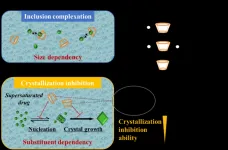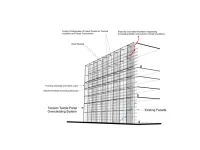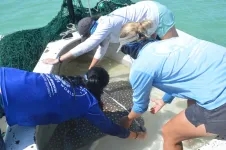(Press-News.org) Fresh insights into the spread of damaging proteins that build up in the brains of people with Alzheimer’s disease could hold the key to stopping the condition progressing, a study says.
Researchers have discovered that synapses, which send essential signals through the brain, are also transporting toxic proteins known as tau around the brain.
Large clumps of the protein tau – called tangles – form in brain cells and are one of the defining features of Alzheimer’s disease. As these tangles spread through the brain during the disease there is a decline in brain function.
Led by the University of Edinburgh, the study focused on synapses, connections which allow the flow of chemical and electrical messages between brain cells and are vital to healthy brain function. Alzheimer’s disease attacks synapses and their loss strongly predicts reduced memory and thinking abilities.
In the study, scientists examined more than one million synapses from 42 people using powerful microscopy techniques to visualise proteins within individual synapses.
The team discovered that small clumps of the protein tau – known as tau oligomers – are found within the synapses of people who died of Alzheimer’s disease.
Tangles of tau oligomers were seen inside both ends of the synapse – from the brain cell sending signals and the brain cell receiving signals.
In a mouse model of the disease, the oligomers jumped from one side of the synapse to the other, spreading the toxic tau through the brain.
Lowering oligomeric tau at synapses may be a promising strategy to stop disease progression in future, experts say.
Alzheimer’s disease is the most common form of dementia, with currently around 900,000 people with the condition in the UK. This figure is projected to rise to nearly 1.6 million in 2040. It can cause severe memory loss and there is currently no cure.
The study is published in the journal Neuron: https://doi.org/10.1016/j.neuron.2023.04.020. [URL will become active after embargo lifts]. The research team included scientists from the University of Edinburgh, the UK Dementia Research Institute, the Institut d'Investigacions Biomèdiques Hospital de Sant Pau and the Institute for Advanced Chemistry of Catalonia (Barcelona).
Lead researcher, Professor Tara-Spires Jones of the UK Dementia Research Institute at the University of Edinburgh, said: “We have known for over 30 years that tangles spread through the brain during Alzheimer’s disease, but how they spread has remained a mystery. Wherever tangles appear in the brain, neuron death follows, contributing to the decline in cognitive ability. Stopping the spread of toxic tau is a promising strategy to stop the disease in its tracks.”
For further information, please contact: Jess Conway, Press and PR Office, 07979 446 209 jess.conway@ed.ac.uk
END
Dementia study reveals how toxic proteins spread through brain
2023-05-15
ELSE PRESS RELEASES FROM THIS DATE:
Combined delivery of engineered virus with immunotherapy is safe and improves outcomes in subset of patients with glioblastoma
2023-05-15
HOUSTON ― Intratumoral delivery of an engineered oncolytic virus (DNX-2401) targeting glioblastoma (GBM) cells combined with subsequent immunotherapy was safe and improved survival outcomes in a subset of patients with recurrent GBM, according to results from a multi-institutional Phase I/II clinical trial co-led by researchers at The University of Texas MD Anderson Cancer Center and the University of Toronto.
The study, published today in Nature Medicine, met its primary safety endpoint and demonstrated the combination was well tolerated overall with no dose-limiting toxicities. The study did not meet its primary efficacy endpoint of objective response rate, but ...
Mass General Brigham investigators identify new genetic variant protective against Alzheimer's disease
2023-05-15
A single patient can spark new research questions and provide answers about a disease. And when a new case is identified, investigators can make connections between them that can lead to even more powerful and persuasive ideas about cause and treatment. In a publication today in Nature Medicine, an international team led by investigators from two Mass General Brigham hospitals — Massachusetts General Hospital (MGH) and Mass Eye and Ear — reports on a new case of a patient with a genetic predisposition for developing early-onset Alzheimer’s disease who remained cognitively intact until his late 60s. Through clinical assessments ...
Out of this world control on Ice Age cycles
2023-05-15
A research team, composed of climatologists and an astronomer, have used an improved computer model to reproduce the cycle of ice ages (glacial periods) 1.6 to 1.2 million years ago. The results show that the glacial cycle was driven primarily by astronomical forces in quite a different way than it works in the modern age. These results will help us to better understand the past, present, and future of ice sheets and the Earth’s climate.
Earth’s orbit around the Sun and its spin axis orientation change slowly over time, due to the pull of gravity from the Sun, the Moon, and other planets. These astronomical forces affect the environment on Earth due to changes in ...
Methylated cyclodextrin effectively prevents the crystallization of supersaturated drugs
2023-05-15
In the medicine market, most newly introduced drugs and drug candidates show poor water solubility, which prevents their absorption in the body. This, in turn, limits their therapeutic efficiency. Solubilizing agents such as cyclodextrins (CDs) are commonly employed to enhance their solubility. CDs have a cyclic structure featuring a hydrophilic exterior and a hydrophobic cavity inside that can enclose drug molecules to form inclusion complexes. However, solubilization does not necessarily enhance drug adsorption in the body, since the solubilized drugs cannot ...
Translating science into impact: Cane-Bridge Foundation donates $1M to Boyce Thompson Institute for Innovative Translational Research Program
2023-05-15
Ithaca, NY (May 15, 2023) - Today, the Boyce Thompson Institute (BTI) is taking a significant step forward in its mission to bridge the gap between scientific discovery and real-world application. Thanks to a generous $1M gift from the Cane-Bridge Foundation, BTI has launched an innovative translational program called "Project Vault!" to propel plant science discoveries into applications that tackle global life science challenges.
"The Cane-Bridge Foundation's support is vital to accelerate ...
Latest research provides SwRI scientists close-up views of energetic particle jets ejected from the Sun
2023-05-15
SAN ANTONIO — May 15, 2023 —Southwest Research Institute (SwRI) scientists observed the first close-ups of a source of energetic particles expelled from the Sun, viewing them from just half an astronomical unit (AU), or about 46.5 million miles. The high-resolution images of the solar event were provided by ESA’s Solar Orbiter, a Sun-observing satellite launched in 2020.
“In 2022, the Solar Orbiter detected six recurrent energetic ion injections. Particles emanated along the jets, a signature of magnetic reconnection involving ...
New project to design building skins to retrofit energy-inefficient structures
2023-05-15
Older buildings tend to leak heat through their walls, requiring much more energy to maintain a comfortable temperature in summer or winter. Those constructed prior to the late 1970s rarely meet today’s more rigorous energy standards. And yet they account for large proportion of the buildings standing today. In the US, about 44% of the residential building stock was built before 1970 and about half of the commercial buildings that exist today were built before the 1980s, which creates a significant need for energy retrofitting to reduce environmental impact. A new industry-academic collaboration between Jefferson and Lightweight ...
Heat-loving marine bacteria can help detoxify asbestos
2023-05-15
Asbestos materials were once widely used in homes, buildings, automobile brakes and many other built materials due to their strength and resistance to heat and fire, as well as to their low electrical conductivity. Unfortunately, asbestos exposure through inhalation of small fiber particles has been shown to be highly carcinogenic.
Now, for the first time, researchers from the University of Pennsylvania have shown that extremophilic bacteria from high temperature marine environments can be used to reduce asbestos’ toxicity. The research is published in ...
First-in-human trial of oral drug to remove radioactive contamination begins
2023-05-15
WHAT:
A first-in-human clinical trial of an experimental oral drug for removing radioactive contaminants from inside the body has begun. The trial is testing the safety, tolerability and processing in the body of escalating doses of the investigational drug product HOPO 14-1 in healthy adults. The National Institute of Allergy and Infectious Diseases (NIAID), part of the National Institutes of Health, is funding the Phase 1 trial, which is sponsored and conducted by SRI International of Menlo Park, California.
Internal radioactive contamination occurs when radioactive ...
Crushed clams, roaming rays: acoustic tags reveal predator interactions
2023-05-15
Clam leases are designated underwater locations used to produce hard clams of all sizes from littlenecks to chowders. Clam production or aquaculture can be a risky business due in part to unwanted marine intruders. Among them, stealthy and highly mobile rays.
The Indian River Lagoon is one key location used for hard clam (Mercenaria mercenaria) aquaculture operations along Florida’s Atlantic coast. Clam fishermen have anecdotally reported seeing rays in clam leases and suspect that their interactions could result in damaged aquaculture gear and crushed clams. After all, ...






